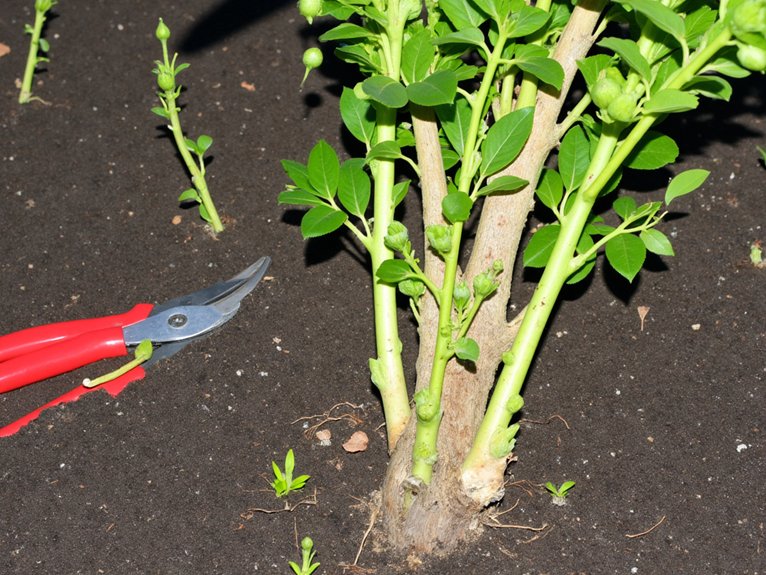Rose enthusiasts face a common challenge when unwanted shoots emerge from beneath their prized bushes. These invasive growths, known as suckers, steal essential nutrients from the grafted rose variety above. “Suckers can reduce flowering by up to 70% if left unchecked,” warns Master Gardener Sarah Chen. Understanding the relationship between rootstock and grafted roses becomes important for maintaining healthy plants, and the first step involves identifying these garden saboteurs lurking below the surface.
Contents
The Secret World of Grafted Roses and Rootstock

Have you ever wondered why your beautiful rose bush occasionally sprouts stems that look completely different from the rest? These unexpected shoots emerge because many garden roses rely on grafting techniques, where prized rose varieties are joined with hardy rootstock varieties.
Common rootstock varieties like ‘Dr. Huey’ and ‘Fortuniana’ provide strength and disease resistance to delicate flowering roses. This fusion occurs at the bud union, a visible knot where the two plants become one. Understanding this hidden partnership helps gardeners identify and manage unwanted growth, ensuring their cherished roses maintain their intended beauty and characteristics.
Spotting Unwanted Growth: Essential Rose Sucker Identification
When gardeners notice unusual stems emerging from their prized rose bushes, identifying these potential suckers becomes essential for maintaining plant health. Key sucker characteristics include long, thin canes with different leaf patterns and thorns than the main plant. These unwanted shoots typically appear below the bud union, where the desired rose variety meets the rootstock.
Effective monitoring techniques involve regular inspections of the plant’s base, particularly in early spring. Gardeners should compare foliage types, noting that sucker leaves often have more leaflets and appear wilder than cultivated varieties. The presence of different-colored blooms also signals rootstock growth requiring prompt removal.
Step-by-Step Guide to Safe Sucker Removal

Every successful rose sucker removal begins with proper preparation and technique to protect both the gardener and the plant. Armed with clean, sharp pruners and sturdy gloves, gardeners should first locate the bud union where the rootstock meets the grafted rose.
For effective sucker removal techniques, grip the unwanted growth firmly at its base and pull downward with a swift motion. “Always remove suckers as close to their point of origin as possible,” advises master gardener Sarah Thompson.
These essential rose care tips guarantee proper healing: make clean cuts, avoid tearing, and monitor the area regularly for new growth.
Healing and Protection: Post-Removal Care Tips
Proper aftercare following sucker removal plays a vital role in maintaining rose plant health and preventing future issues. During post removal healing, gardeners should monitor the area daily for signs of infection or new growth.
For wound protection, experts recommend keeping the soil around the removal site slightly dry. “Excess moisture can invite fungal problems,” notes rosarian Sarah Chen. “Allow the wound to form a natural callus.”
Some gardeners apply commercial rose sealant, though this remains optional. The key is maintaining cleanliness around the wound site and ensuring proper air circulation. Regular inspection helps catch potential problems early.
Long-Term Success: Maintaining Healthy Rose Gardens

Successful rose gardens depend on consistent monitoring and maintenance throughout the growing season to prevent sucker regrowth. Experts recommend monthly inspections, focusing on proper rose nutrition through balanced fertilization and regular pest management practices.
“A well-maintained rose garden requires vigilance,” notes horticulturist Dr. Sarah Chen. “Check plants weekly during spring growth, applying balanced 5-10-5 fertilizer every six weeks, and implementing integrated pest management strategies.”
Key maintenance tasks include:
- Removing dead or crossing branches
- Maintaining 2-3 inches of mulch
- Inspecting for signs of disease or pests
- Pruning for proper air circulation
- Testing soil pH twice yearly
